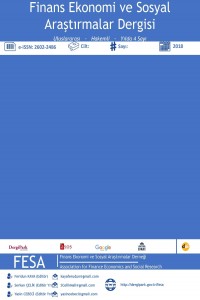İHRACATTA TEDARİKÇİ KREDİ RİSKİNİN GARANTİ ALTINA ALINMASINDA FAKTORİNG, İHRACAT ARTIŞINA VE EKONOMİK BÜYÜMEYE DESTEĞİ
Abstract
Keywords
Faktoring Ticari Alacak Riski Ters Faktöring Tedarik Zinciri Finansmanı Açık Hesap Tedarikçi Kredisi
References
- Kaynakça Global Supply Chain Forum, Standard Definitions for Techniques of Supply Chain Finance. https://data.wto.org
- https://www.berneunion.org/DataReports[2020].
- Barbuta, N., 2013. Risk in Contemporary Economy. Galati,Romania.
- Brennan, M., Maksimovic, V. & Zehner, J., 1988. Vendor Financing. Journal of Finance, 43(5), pp. 231-54.
- Çarıkçıoğlu, P. S., 1995. Faktoring, Türkiye uygulamasındaki Son Yasal Düzenlemeler ve Sorunları. Yönetim, Issue 20, pp. 17-23.
- Çetiner, M. & Eke, S., 2018. Güncel Gelişmeler Işığında Kredi Sigortası Pazarı ve Makro Açıdan İrdelenmesi. Social Science Development Journal, 3(12), pp. 497-507.
- Ekiyor, S. C. & Tosyalı, A., 2016. As A Supply Chain Financing Source, Trade Credit and Bank Credit Relationship During Financial Crises from Clustering Point of View. International Business Research, 9(4), pp. 45-57.
- Ekmekçioğlu, R. ve diğerleri, 2002. Faktoring Eğitim Programı El Kitabı. Istanbul: Faktoring Derneği.
- European Central Bank , 2019. Survey on the Access of Enterprises in the Euro Area, April to September.
- Factors Chain International,https://fci.nl/en/solutions/factoring/factoring_products
- Factors Chain International, FCIReverse, https://fci.nl/en/about-fci-new/about-fci[Mart 2020].
- FCI Annual Review, 2019.
- Ferrando, A. & Mulier, K., 2013. Do Firms Use the Trade Credit Channel to Manage Growth? Journal of Banking & Finance, Cilt 37, pp. 3035-3046.
- Finansal Kurumlar Birliği,https://www.fkb.org.tr/sektorler/faktoring/[Mart 2020].
- Finansal Kurumlar Birliği,
- https://www.fkb.org.tr/Sites/1/upload/files/Faktoring_Sektoru_Ozet_Finansal_Veriler_2018_12-1728.pdf
- Fisman , R. & Love, I., 2003. Trade Credit, Financial Intermediary Development And Industry Growth.http://www.jstor.org/stable/3094490 )[Mart 2020].
- Global Supply Chain Finance Forum, 2016. Standard Definitions for Techniques of Supply Chain Finance, Global Supply Chain Finance Forum. https://iccwbo.org/content/uploads/sites/3/2017/01/ICC-Standard-Definitions-for-Techniques-of-Supply-Chain-Finance-Global-SCF-Forum-2016.pdf
- Grath, A., 2008. The Handbook of International Trade and Finance. İngiltere: Kogan Page.
- İslamoğlu, M. & Ayhan, F., 2013. Türk Faktoring Sektöründe Finansman ve Nakit Yönetiminin Yapısı: Kümülatif Nakit Akış Modeli Önerisi. Ekonomik ve Sosyal Araştırmalar Dergisi, 9(2), pp. 171-187.
- Janekova, J., 2012. Factoring – Altenative Source of a Company Financing , Annals of Faculty Engineering hUNEDOARA. International Journal of Engineering, Cilt 3.
- Jones, P. M., 2010. Trade Credit Insurance, Primer Series on Insurance.
- Kavcıoğlu, Ş., 2019. Dünyada ve Ülkemizde “Factoring” Uygulamaları-Tedarik Zinciri Finansmanında "Factoring"in Rolü. Sosyal Bilimler Araştırma Dergisi!, 8(3), pp. 67-90.
- Klapper, L., 2005. The Role of Factoring for Financing Small and Medium Enterprises, USA: World Bank.
- https://pdfs.semanticscholar.org/a8de/59dcf9341e55a57fd0b6f9fb83153fb8b1dc.pdf
- Li, Y., 2014. Trade Credit Insurance, Capital Constraint and the Behaviour of Manufacturers and Banks. USA: Springer Science and Business Media.
- Lotte, C. & Keza, W., 2019. Statictical Coverage of Trade Finance- Fintechs and Supply Chain Financing, USA: IMF.
- Nilsen, J., 1999. Trade Credit&the Bank Lending Channel Working Paper, Swiss National Bank.
- OECD, 2019. Financing SMEs and Entrepreneurs: Recent Trends in SME and Entrepreneurship Finance.
- Petersen, M. & Raghuran, G., 1997. Trade Credit: Theories And Evidence The Review Of Financial Studies.http://www.jstore.org/stable/2962200[Mart 2020].
- Shehzad, L. M. & Clifford, W. S., 1992. Accounts Receivable Management Policy : Theory and Evidence. The Journal of Finance, Vol XLVII,(1).
- Soufani, K., 2002. On the Determinants of Factoring as a Financing Choice: Evidence from UK. Journal of Economics and Business, Cilt 54, pp. 239-252.
- Suzana Baresa, I. S. & Sinisa, B., 2011. Factoring: Alternative Model of Financing. UTMS Journal of Economics, 2(2), pp. 189-206.
- Türk Eximbank, https://www.eximbank.gov.tr/tr/finansal-bilgiler/faaliyet-raporlari[ 2020].
- Türk Sigorta Birliği, https://www.tsb.org.tr/resmi-istatistikler.aspx?pageID=909[ 2020].
- Türkiye İstatistik Kurumu http://www.tuik.gov.tr/PreTablo.do?alt_id=1046
- Uyanık, Y., 2015. Dünyada ve Türkiye'de Faktoring Tanımı. Gazi Üniversitesi Sosyal Bilimler Dergisi, 2(3), pp. 23-40.
- Uyanık, Y. R., 2012. Uluslararası Faktoring Genel Kuralları.
- World Bank, Doing Business.
- Rhttps://openknowledge.worldbank.org/bitstream/handle/10986/32436/9781464814402.pdf [04 Mart 2020].
- Xia, J., 2017. Trade Credit, Financing Structure and Growth.
Details
| Primary Language | Turkish |
|---|---|
| Subjects | Business Administration |
| Journal Section | Araştırma Makaleleri |
| Authors | |
| Publication Date | June 30, 2020 |
| Submission Date | May 1, 2020 |
| Acceptance Date | June 18, 2020 |
| Published in Issue | Year 2020 Volume: 5 Issue: 2 |

